| Article ID | Journal | Published Year | Pages | File Type |
|---|---|---|---|---|
| 5201963 | Polymer Degradation and Stability | 2014 | 10 Pages |
Abstract
A non-destructive UV-Vis spectroscopic method to study the aging of nitrocellulose (NC) has been described. The method involves determining the change of absorbance with time of a dye mixed with NC in a thin film. During the aging of the NC two secondary and one primary CO-NO2 groups at the anhydroglucopyranose (AHP) ring positions C2, C3 and C6 undergo decomposition and this leads to NOx formation. The NOx nitrates the dye and the decrease in the concentration of the original un-nitrated dye is followed by UV-Vis spectroscopy. Thin films with uniform thickness were prepared on glass slides by casting solutions of NC in butanone containing an anthraquinone dye (SB59) and dioctyl phthalate as a plasticiser. The colour of the films changed gradually from blue to red during accelerated thermal aging, in line with changes in the UV-Vis spectra of the dye and its nitrated derivatives. The reaction of the dye with NOx was monitored by periodically recording the absorption spectra of the films. The graphs of the logarithmic absorbance as function of aging time produced non-linear plots. However, splitting the data into three time intervals was found to give rise to three linear regions with three distinct rate constants. In an initial attempt at modelling, first order-rate constants were obtained from the gradients of the 'ln(AS(0)/AS(t)) vs aging time' plots. The Arrhenius expressions derived from the data for the three time intervals at 40 °C, 50 °C, 60 °C and 70 °C gave three activation energy values, which are seen to correspond to the homolytic breakdown of CO-NO2 groups at the C2, C3 and C6 ring positions on NC. In a further step, the data were evaluated with extended modelling using (i) a first order description, (ii) a second order description and (iii) an nth order description. This modelling considered the data as a whole; no splitting of data in time intervals and no single temperature evaluation has been made. Some differences can be recognized between the first order and second order models. However, the results from these evaluations agree satisfactorily with each other and with quantum chemical calculations of the bond dissociation enthalpies of the CO-NO2 bonds at the three ring positions. In this way, the data could be assigned to the anhydroglucopyranose ring positions of the CO-NO2 groups. Based on all data and literature results the order of stability of the CO-NO2 groups was concluded to be C6 > C2 > C3.
Related Topics
Physical Sciences and Engineering
Chemistry
Organic Chemistry
Authors
Mohammed Moniruzzaman, John M. Bellerby, Manfred A. Bohn,
